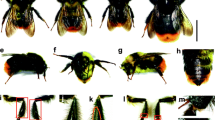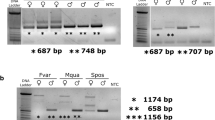Abstract
Gynandromorphy, or the development of organisms with a combination of male and female morphological features, is common in Hymenoptera. The underlying mechanism is likely associated with the sex-determination system, and studying this phenomenon should lead to a deeper understanding of both embryonic development and sex determination. The reproductive capabilities of gynandromorphs (hereafter, sex mosaics) remain unclear. We studied gynandromorphy in the Malaysian ant Cardiocondyla kagutsuchi, which has sex mosaics of queens (gynandromorphs; mosaic of queens and winged male) and workers (ergatandromorphs; mosaic of worker and wingless ergatoid male). These sex mosaics were classified into seven morphological categories. Most individuals had more male than female body areas. Behavioral observations revealed that sex mosaics behave more in accordance with the “sex” of their brain than that of the reproductive organs (gaster). Relative DNA quantities showed that both female and male regions contained haploid and diploid nuclei, irrespective of their phenotypic appearance, indicating that external appearance did not reflect internal tissues. Nearly one third of the adults were sex mosaics and they were not infected with Wolbachia. Our results suggest that the production of sex mosaics in this species does not pose a substantial cost to colonies and that the underlying causes are therefore not strongly selected against.


Similar content being viewed by others
References
Abouheif E, Wray GA (2002) Evolution of the gene network underlying wing polymorphism in ants. Science 297:249–252
Aron S, Menten L, Bockstaele DRV, Blank SM, Roisin Y (2005) When hymenopteran males reinvented diploidy. Cur Biol 15:824–827
Berndt KP, Kremer G (1982) Heat shock-induced gynandromorphism in the pharaoh’s ant, Monomorium pharaonis (L.). Experientia 38:798–799
Berndt KP, Kremer G (1983) New categories in the gynandromorphism of ants. Insect Soc 30:461–465
Brockmann A, Brückner D (1999) Dimorphic antennal systems in gynandromorphic honey bees, Apis mellifera 1. (Hymenoptera: Apidae). Inter J Insect Morphol 28:53–60
Cook JM (1993) Sex determination in the Hymenoptera: a review of models and evidence. Heredity 71:421–435
Cremer S, Lautenschläger B, Heinze J (2002) A transitional stage between the ergatoid and winged male morph in the ant Cardiocondyla obscurior. Insect Soc 49:221–228
Fournier D, Estoup A, Orivel J, Foucaud J, Jourdan H, Breton JL, Keller L (2005) Clonal reproduction by males and females in the little fire ant. Nature 435:1230–1234
Heinze J, Trenkle S (1997) Male polymorphism and gynandromorphs in the ant Cardiocondyla emeryi. Naturwissenschaften 84:129–131
Hotta Y, Benzer S (1972) Mapping of behaviour in Drosophila mosaics. Nature 240:527–535
Hotta Y, Benzer S (1976) Courtship in Drosophila mosaics sex-specific foci for sequential action patterns. Proc Natl Acad Sci U S A 73:4154–4158
Jones SR, Phillips Jr SA (1985) Gynandromorphism in the ant Pheidole dentata Mayr (Hymenoptera, Formicidae). Proc Entomol Soc Washington 87:583–586
Kinomura K, Yamauchi K (1994) Frequent occurrence of gynandromorphs in the natural population of the ant Vollenhovia emeryi (Hymenoptera: Formicidae). Insect Soc 41:273–278
Kondo N, Shimada M, Fukatsu T (1999) High prevalence of Wolbachia in the adzuki bean beetle Callosobruchus chinensis (Coleoptera, Bruchidae). Zool Sci 16:955–962
Kondo N, Ijichi N, Shimada M, Fukatsu T (2002) Prevailing triple infection with Wolbachia in Callosobruchus chinensis (Coleoptera: Bruchidae). Mol Ecol 11:167–180
Martin P, Amelia A, Thomas L, Erwin HB (1995) Evaluation of sensitivity of flow cytometry in detecting aneuploidy in wheat using disomic and ditelosomic wheat-rye addition lines. Cytometry 21:387–393
Ohkawara K, Nakayama M, Satoh A, Trindl A, Heinze J (2006) Clonal reproduction and genetic caste differences in a queen-polymorphic ant, Vollenhovia emeryi. Biol Lett 2:359–363
O’Neill SL, Giordano R, Colbert AME, Karr TL, Robertson HM (1992) 16S rRNA phylogenetic analysis of the bacterial endosymbionts associated with cytoplasmic incompatibility in insects. Proc Natl Acad Sci U S A 89:2699–2702
Rigaud T, Juchault P (1993) Conflict between feminizing sex ratio distorters and an autosomal masculinizing gene in the terrestrial isopod Armadillidium vulgare Latr. Genetics 133:247–252
Rothenbuhler WC, Gowen JW, Park OW (1952) Androgenesis with zygogenesis in gynandromorphic honeybees (Apis mellifera L.). Science 115:637–638
Rousset F, Bouchon D, Pintureau B, Juchault J, Solignac M (1992) Wolbachia endosymbionts responsible for various alternations of sexuality in arthropods. Proc R Soc Lond B 250:91–98
Schrempf A, Heinze J (2006) Proximate mechanisms of male morph determination in the ant Cardiocondyla obscurior. Evol Develop 8:266–272
Walsh PS, Metzger DA, Higuchi R (1991) Chelex 100 as a medium for simple extraction of DNA for PCR-based typing from forensic material. Bio Techniques 10:506–513
Wcislo WT, Gonzalez VH, Arneson L (2004) A review of deviant phenotypes in bees in relation to brood parasitism, and a gynandromorph of Megalopta genalis (Hymenoptera: Halictidae). J Nat Hist 38:1443–1457
Wenseleers T, Ito F, Van Born S, Huybrechts R, Volchaert F, Billen J (1998) Widespread occurrence of the micro-organism Wolbachia in ants. Proc R Soc Lond B 265:1447–1452
Whiting PW (1928) Mosaicism and mutation in Habrobracon. Biol Bull 54:289–307
Whiting PW, Stancati MF (1931) A gynandromorph of Habrobracon from a post-reduced binucleate egg. Biol Bull 61:481–484
Yamauchi K, Asano Y, Lautenschlager B, Trindl A, Heinze J (2005) A new type of dimorphism with ergatoid and short-winged males in Cardiocondyla cf. kagutsuchi. Insect Soc 52:274–281
Acknowledgments
We are grateful to M.S. Hirai, Chiyoda Science, and Ikedarika for assistance with the DNA analysis and Dr. R. Hashim, Institute of Biology, University of Malaya, for his valuable suggestions in the fieldwork in Malaysia. We thank Dr. N. I. Kondo for kindly providing the primer pairs. We also thank Drs. J. Heinze and J. Abe for their valuable comments and suggestions to improve our manuscript. Comments by three anonymous reviewers were enormously helpful to improving our manuscript. This work was supported by a grant-in-aid for scientific research from the Japan Society for the Promotion of Science (number 14405036).
Author information
Authors and Affiliations
Corresponding author
Rights and permissions
About this article
Cite this article
Yoshizawa, J., Mimori, K., Yamauchi, K. et al. Sex mosaics in a male dimorphic ant Cardiocondyla kagutsuchi . Naturwissenschaften 96, 49–55 (2009). https://doi.org/10.1007/s00114-008-0447-z
Received:
Revised:
Accepted:
Published:
Issue Date:
DOI: https://doi.org/10.1007/s00114-008-0447-z




